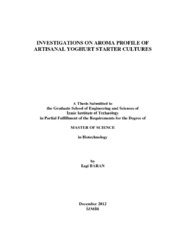Please use this identifier to cite or link to this item:
https://hdl.handle.net/11147/3542Full metadata record
| DC Field | Value | Language |
|---|---|---|
| dc.contributor.advisor | Harsa, Hayriye Şebnem | en |
| dc.contributor.author | Baran, Ezgi | - |
| dc.date.accessioned | 2014-07-22T13:51:46Z | - |
| dc.date.available | 2014-07-22T13:51:46Z | - |
| dc.date.issued | 2012 | en |
| dc.identifier.uri | http://hdl.handle.net/11147/3542 | - |
| dc.description | Thesis (Master)--Izmir Institute of Technology, Biotechnology, Izmir, 2012 | en |
| dc.description | Includes bibliographical references (leaves: 55-61) | en |
| dc.description | Text in English; Abstract: Turkish and English | en |
| dc.description | ix, 62 leaves | en |
| dc.description | Full text release delayed at author's request until 2015.01.08 | en |
| dc.description.abstract | Yoghurt is an important fermented milk product that is consumed widely around the world as a part of the diet. Yoghurt is produced by lactic acid fermentation using Streptococcus thermophilus, and Lactobacillus delbrueckii ssp. bulgaricus. The most important criteria in yoghurt production are the selection of artisanal yoghurt starter cultures to achieve the typical aroma and quality of the final product. The typical aroma of yoghurt is identified chiefly by acetaldehyde that is the most important for yoghurt aroma. The aim of this study is to determine artisanal yoghurt starter cultures that provide the most desirable aroma to yoghurt, in order to promote industrial production with such flavor. In the first part of this study, the influence of different aroma cultures addition on the aroma production properties in yoghurt products was investigated. Nine different aroma cultures were added into the starter culture combinations at two different inoculation ratios. Among all of the combinations, just one yoghurt combination was selected according to the highest acetaldehyde and also the highest sensory scores. According to the results, two batches of yoghurt were produced: Sample 1 containing only yoghurt starter cultures (Lactobacillus bulgaricus Y30 + Streptococcus thermophilus Y24), was used as control yoghurt; Sample 2 containing yoghurt starter cultures plus with selected aroma culture (P10), was used as yoghurt with aroma culture. Yoghurt samples were stored at 4 °C for 21 days. The pH, titratable acidity, total solids, fat, protein, syneresis, viscosity, aroma profile, lactic acid and lactose profile, proteolytic activity, microbiological characteristics and sensory characteristics | en |
| dc.language.iso | en | en_US |
| dc.publisher | Izmir Institute of Technology | en_US |
| dc.rights | info:eu-repo/semantics/openAccess | en_US |
| dc.subject.lcsh | Aromatic compounds | en |
| dc.subject.lcsh | Acetaldehyde | en |
| dc.subject.lcsh | Lactobacillus bulgaricus | en |
| dc.subject.lcsh | Streptococcus thermophilus | en |
| dc.subject.lcsh | Yogurt | en |
| dc.subject.lcsh | Gas chromatography | en |
| dc.subject.lcsh | Lactic acid bacteria | en |
| dc.title | Investigations on aroma profile of artisanal yoghurt starter cultyres | en_US |
| dc.type | Master Thesis | en_US |
| dc.institutionauthor | Baran, Ezgi | - |
| dc.department | Thesis (Master)--İzmir Institute of Technology, Bioengineering | en_US |
| dc.relation.publicationcategory | Tez | en_US |
| item.languageiso639-1 | en | - |
| item.fulltext | With Fulltext | - |
| item.openairecristype | http://purl.org/coar/resource_type/c_18cf | - |
| item.openairetype | Master Thesis | - |
| item.grantfulltext | open | - |
| item.cerifentitytype | Publications | - |
| Appears in Collections: | Master Degree / Yüksek Lisans Tezleri | |
Files in This Item:
| File | Description | Size | Format | |
|---|---|---|---|---|
| 452845.pdf | MasterThesis | 952.43 kB | Adobe PDF |  View/Open |
CORE Recommender
Page view(s)
142
checked on Jul 22, 2024
Download(s)
138
checked on Jul 22, 2024
Google ScholarTM
Check
Items in GCRIS Repository are protected by copyright, with all rights reserved, unless otherwise indicated.